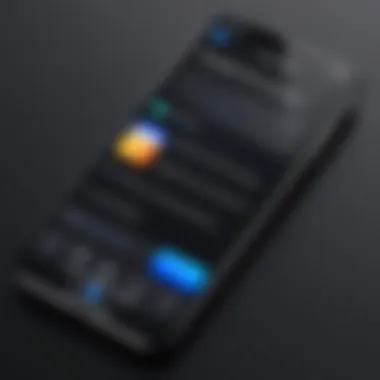Recovering Deleted iPhone Messages: Complete Guide


Intro
In the digital era, where messages can be sent and received in the blink of an eye, the ability to retrieve deleted messages on an iPhone can make a world of difference. We all have that fleeting moment of panic when we accidentally swipe left on a conversation that held precious information. Whether it's a cherished text from a loved one or crucial work-related details, losing messages can feel like misplacing a piece of your digital identity.
This guide aims to illuminate the path towards recovering those lost conversations. We will dive into the methods available—from built-in features in iOS to third-party applications designed specifically for data recovery. Plus, we’ll touch on strategies to help prevent future mishaps, ensuring that your iPhone remains a reliable companion for your day-to-day communications.
The relevance of mastering message recovery cannot be overstated. It's not only a matter of convenience but also of safeguarding vital information that can impact personal and professional domains. As technology evolves, so too must our understanding of how to navigate these tools effectively.
So, hang tight as we embark on a comprehensive exploration of this crucial topic.
Understanding iPhone Data Management
Understanding how data management works on an iPhone is crucial for anyone who uses this device regularly. With the modern reliance on smartphones for communication, important messages can easily be lost with the stroke of a finger. Knowing how to navigate and manage your data helps to recover messages and avoids a sense of panic when you've accidentally deleted something significant. This section delves into the core elements and implications of iPhone data management, setting the stage for effective recovery methods later in this guide.
How Data Storage Works on iOS
iOS, Apple's operating system, organizes data in a sophisticated way that enables devices to operate smoothly. Each app has its own space where it can store information, which can be system files, user-generated content, or settings. Think of it like various compartments in a filing cabinet. Messages on iPhones are stored within the Messages app's database, which is constantly updated as new messages are sent or received.
- Files and Databases: iPhones primarily use SQLite databases for managing messages. Every message sent or received is recorded meticulously, even when deleted, until the storage reaches a critical limit.
- Storage Capacity: Each iPhone model comes with a different storage capacity, affecting the amount of data you can keep. For instance, an iPhone with 64GB may store fewer messages than a 256GB model. Users must be mindful of this, especially when dealing with a high volume of texts, ensuring that critical information remains accessible.
This intricate storage method allows efficient retrieval for apps to run seamlessly, yet it comes with its quirks. Users can sometimes feel like they're playing a game of hide-and-seek with their data, particularly when they delete items that seem to vanish into thin air.
What Happens When Messages Are Deleted
When a message is deleted, it might feel like it’s gone for good, but that’s not always the case. In truth, the message data doesn’t necessarily get wiped from the device immediately. Instead, it’s more akin to marking a book as discarded—while the book still exists on the shelf, it's marked as unavailable. Here's what typically happens:
- Marking for Deletion: The iOS system marks the deleted messages as no longer needed, freeing up space for new messages. This method is akin to marking an item off a to-do list without actually throwing it in the bin.
- Storage Overwrite: Eventually, when your device requires more space, it may overwrite this marked data with new information. At this point, recovering that deleted message becomes increasingly difficult.
- iCloud and Backups: If the user regularly backs up their device, deleted messages could potentially be recoverable through those backups, providing a glimmer of hope for those in a tighter spot.
Understanding these processes emphasizes the importance of prompt action after message deletion. The window for recovery depends on user habits regarding backups and how quickly the system overwrites the data.
“Knowing how your data works can make the difference between losing an important message and recovering it.”
By grasping how iOS handles data, users empower themselves to be proactive rather than reactive when managing communications on their devices, laying the groundwork for exploring recovery options in the sections that follow.
Exploring Built-in Recovery Options
When it comes to retrieving deleted messages on your iPhone, understanding built-in recovery options is crucial. These tools serve as your first line of defense against unintentional message loss. Relying on Apple's native features not only saves you time but also maximizes your chances of successful recovery without resorting to third-party solutions. Knowing where to look and what steps to follow can make all the difference when messages go missing.


Checking the 'Recently Deleted' Folder
One of the most overlooked features on an iPhone is the 'Recently Deleted' folder, a digital safe harbor for deleted messages. This folder is akin to a recycling bin—it temporarily holds messages for a limited time before permanently erasing them. To check this folder, follow these steps:
- Open the Messages app.
- Tap on the **** icon in the top left corner to go back to the conversation list.
- Scroll to the bottom and look for the ‘Recently Deleted’ section, if available.
Remember, messages linger here only for 30 days before vanishing for good. If you discover your missing messages in this section, simply tap on them and choose to restore. However, if this folder is empty or the timeframe has passed, don’t throw in the towel just yet.
Restoring from iCloud Backup
For those who utilize iCloud, restoring from a backup can be a lifesaver. The beauty of iCloud lies in its capacity to create automatic backups, provided it's set up correctly. Here's how to carry out the restoration process:
- Go to Settings on your iPhone.
- Tap on your name at the top and then select iCloud.
- Navigate to Manage Storage, followed by Backups.
- Here, you can see the date of your last backup. If it predates the message deletion, you’re in luck!
- To restore, you need to reset your device to factory settings by going back to Settings > General > Transfer or Reset iPhone > Erase All Content and Settings.
- Once your iPhone restarts, proceed with the setup process and choose to restore from an iCloud backup, selecting the relevant backup to include your deleted messages.
Keep in mind that restoring an iCloud backup means losing any data added after the backup date, so weigh this option carefully.
Recovering via iTunes Backup
For users who prefer iTunes, this application can provide a reliable path to recover deleted messages as well. If you’ve regularly backed up your iPhone through iTunes, here's what you need to do:
- Connect your iPhone to the computer that contains your iTunes backup.
- Open iTunes (on macOS Catalina and later, use Finder).
- Select your device icon and navigate to Summary.
- Under the Backups section, choose Restore Backup.
- Pick the most relevant backup file and begin the restore process.
Like restoring from iCloud, this method will replace the current data on your iPhone with the data from the selected backup. Therefore, be sure to back up your current data first to avoid any potential losses.
Third-party Applications for Message Recovery
When tackling the challenge of message retrieval on an iPhone, the role of third-party applications cannot be overlooked. These software solutions often serve as essential tools, particularly when you find yourself in a tight spot with no built-in options at your disposal. They open up avenues that iOS's native features might not cover, providing additional layers of functionality that can make a significant difference in retrieving lost data.
Third-party applications vary widely in terms of usability and effectiveness. Some options might come with additional bells and whistles, while others aim for tight functionality. In any case, understanding how to navigate these tools is vital, especially since not all apps deliver on their promises. Here's a dive into evaluating your options, along with practical advice for using recovery apps effectively to maximize your chances of success.
Evaluating Recovery Software Options
When it comes to selecting the right recovery software, it's paramount to approach this choice with a discerning eye. Start by considering a few key factors that can affect both your recovery chances and the safety of your personal data. Here’s what to keep in mind:
- User Reviews and Reputation: Take the time to sift through what other users are saying. Platforms like Reddit and tech forums can provide insights that you won't find on promotional webpages.
- Features Offered: Different software solutions offer various tools. A robust app might not only recover messages but also restore photos, notes, or even lost contacts. If you’re needing a multi-faceted solution, that’s definitely worth considering.
- Compatibility: Ensure that the software supports your specific iPhone model, as well as the version of iOS you're running. Sometimes, what works on one OS version may not work on another.
- Trial Versions: Look for applications that provide trial versions. These can allow you to test the waters without making a financial commitment upfront.
- Customer Support: In the event something goes awry during recovery, it’s essential to have a safety net. Responsive customer support is crucial.
How to Use Recovery Apps Effectively
Once you've selected a suitable recovery application, understanding how to use it effectively is the next crucial step. Here are some best practices:


- Preparation: Before diving into the recovery process, ensure that your device is charged and that you have enough storage space for any recoverable files.
- Follow Directions Precisely: Each tool comes with its own set of instructions. Make sure to follow them meticulously to avoid unnecessary hiccups during the recovery process.
- Refrain from Using the Device: Avoid using your iPhone for any other activity during the recovery process. Doing so minimizes the risk of overwriting data that could still be recoverable.
- Scan Thoroughly: When you initiate the recovery scan, allow it to run its course. Rushing through can mean missing that one elusive message.
- Save and Verify: After recovery concludes, check and confirm the integrity of the retrieved messages. Make sure everything you need is intact before considering the process a success.
The key to a successful recovery using third-party applications is a combination of diligence, patience, and systematic approach. You’ve got to play it smart!
Though results can vary depending on the severity of your data loss, using third-party recovery applications offers a valuable alternative when traditional methods fall short. With the right approach, you can significantly increase your chances of recovering those important conversations from the past.
Preventative Measures for Future Instances
Preventative measures are not just a safety net; they’re the backbone of good data management practices. Developing a habit of regular backups and enabling syncing features ensures that you don’t find yourself scrambling to recover lost messages. Being proactive can save you a lot of headaches down the line.
Regular Backup Practices
In today’s fast-paced world, we rely heavily on our smartphones for communication. This makes it essential to establish a routine for backing up your iPhone data. Regular backups help capture snapshots of your information, allowing for recovery when things go awry. There are a few methods for backing up your iPhone:
- iCloud Backup: Automatically backs up your device daily when connected to Wi-Fi. It's convenient and effortless but requires ample storage space.
- iTunes Backup: Allows more control over what is backed up and can store backups locally on your computer. A good option for users wanting to password protect backups!
- Third-Party Software: If you prefer having multiple backup versions, consider solutions like iMazing or Dr.Fone, which offer flexible backup options.
The key takeaway here is that consistency is crucial. Schedule backups, perhaps weekly or monthly, to ensure your vital data is backed up without fail.
Enabling iCloud Sync for Messages
With the advent of modern messaging, it’s easy to overlook the features that help maintain your important conversations. Enabling iCloud Sync for Messages is one such feature that deserves your attention. When activated, this feature ensures your messages are not only stored on your iPhone but also synced across all devices signed into the same Apple ID.
Here’s why enabling iCloud Sync should be on your to-do list:
- Accessibility: Messages can be retrieved from any Apple device. Lost your phone? No problem—just grab your iPad or Mac.
- Automatic Updates: Changes in messages, including deletions and new messages, are reflected in real-time across your devices, allowing you to stay up-to-date.
- Space Management: When you delete messages from one device, they disappear from your others as well, ensuring your devices remain clutter-free, though this comes with a caveat: those deleted messages are gone for good.
To enable iCloud Sync for Messages, head to Settings > [your name] > iCloud > Ensure Messages is toggled on.
Always remember, a stitch in time saves nine. Taking these small steps may spare you greater trouble when you accidentally lose that cherished conversation.
Exploring Alternative Communication Platforms
In today’s digital world, our communication methods have evolved beyond simple text messages. Exploring alternative communication platforms is crucial, especially as they offer new methods of message management and recovery. With various apps available, users can enjoy features that not only enhance communication but also provide better data security and backup options. Choosing the right platform helps prevent the loss of important conversations since many of these applications have built-in cloud services, making retrieving deleted messages a simpler matter compared to traditional texting.
Using Messaging Apps with Cloud Backup
When it comes to modern messaging, apps like WhatsApp, Signal, and Telegram stand out thanks to their cloud backup features. These platforms automatically synchronize your messages to a cloud service, allowing you to restore chat histories, even after deleting them accidentally.
- WhatsApp: Users can back up their chats locally or to cloud services like Google Drive. This guarantees that if a message or an entire conversation is deleted, you can restore it from the most recent backup.
- Signal: While it does not back up data to the cloud, it permits local backups. This feature is invaluable when transitioning to a new phone or restoring data from a previous one.
- Telegram: Telegram stores messages on its cloud, allowing for access across devices seamlessly. If something gets deleted accidentally, messages can often be retrieved if it’s within the app's retention policy.


Adopting a messaging app with such capabilities not just simplifies recovery, but it also adds layers of convenience that traditional SMS lacks. This means that you can easily retrieve not just the text but the multimedia files shared in those conversations too, which are often more valuable than words alone.
Assessing Security Features of Popular Apps
While the convenience offered by messaging applications is clear, users must also delve into security. The right messaging platform should have robust security protocols to safeguard private conversations.
- End-to-End Encryption: Apps like Signal and WhatsApp use this feature to ensure that messages can only be read by the sender and recipient. Even the service provider cannot access this data, which makes it safe from unwanted eyes.
- Data Retention Policies: Each app has different practices regarding how long they keep deleted messages stored. Knowing this can save users a lot of headaches. Apps with shorter retention times may delete data indefinitely, while others might allow for some recovery under certain conditions.
- Two-Factor Authentication: Enabling this feature adds a layer of protection against unauthorized access and ensures that if your account is compromised, it becomes significantly harder for intruders to gain full access.
Legal and Privacy Considerations
When dealing with deleted messages on an iPhone, it's paramount to understand the legal and privacy implications surrounding data recovery. This understanding is crucial not only for effectively navigating the recovery process but also for ensuring compliance with legal standards and protecting personal information during recovery attempts. In a world where data breaches and privacy concerns are rampant, this section sheds light on the vital elements that one must consider before proceeding with recovery methods.
Understanding Data Recovery Laws
The landscape of data recovery laws is intricate and can vary significantly from one jurisdiction to another. In essence, these laws dictate how data, including deleted messages, can be accessed and recovered. One of the core aspects to look at is consent. Without proper authorization, accessing someone else’s messages can lead you down a slippery slope of legal issues.
For instance, consider the general principle that unauthorized access to data can be deemed illegal under laws like the Computer Fraud and Abuse Act in the United States. This means that users must tread carefully, particularly when using third-party recovery software. Bringing the law into the picture, recovering deleted data could stir up questions related to privacy violations, especially if sensitive data is involved.
Moreover, awareness of how long your data is retained on platforms, as well as the scope of data rights provided by local legislation, is also essential.
"Ignorance of the law excuses no man" – a saying our parents often told us that rings true in this domain. If you’re unaware of your rights and responsibilities, you could inadvertently step into complicated legal waters.
Safeguarding Personal Information
To guard against accidental data breaches during the recovery process, a thoughtful approach is required. While the goal may be to recover lost messages, it is paramount that personal information is also protected throughout this journey. Here are key factors to consider:
- Use Trusted Software: Utilizing third-party recovery tools can open doors to potential risks, including malware or phishing attempts. Always opt for software that has good reviews and is reputable in the tech community.
- Read the Fine Print: Many apps require user information or access to your data. Carefully analyze end-user license agreements to identify how your information will be stored or used.
- Limit Access: Be judicious about the permissions you grant. Avoid unnecessary access, especially to sensitive information.
- Regular Audits: Routinely check your device settings to ensure that only necessary backups are active. Regularly reviewing permissions can help spot and eliminate vulnerabilities.
In a nutshell, understanding the legal ramifications and safeguarding your data during the recovery process is not just advised but essential. The interaction between data recovery and privacy can be complex, underscoring why a clear grasp of laws and protective measures is valuable for any iPhone user.
Closure: Mastering Message Recovery
In this digital age, where our communications often live on our devices, the need to recover deleted messages becomes paramount. Understanding how to effectively manage and recover data on your iPhone not only prevents frustration but also safeguards vital information. The techniques covered in this article form the foundation for navigating the complexities of iOS data systems and recovering conversations that may feel long gone.
The process of retrieving lost messages is not merely a technical endeavor; it’s a matter laden with emotional significance. Be it a cherished message from a loved one or an important work-related text, losing those words can feel like losing a part of oneself. It’s crucial to have reliable methods at your disposal. From built-in recovery options provided by Apple to third-party applications that expand recovery capabilities, these tools empower users to take control of their data.
Key Considerations
- Familiarity with iPhone’s data management is essential.
- Regular backups and iCloud sync act as safety nets.
- It’s necessary to assess the efficacy of third-party software carefully, ensuring that privacy and security are upheld.
By mastering the skills discussed in this guide, you position yourself as a proactive planner rather than a reactive fixer. Embracing a holistic view of your data management strategy—anticipating issues before they arise and employing regular maintenance practices—can make a significant difference. The importance of staying informed about the latest developments in data recovery techniques cannot be overstated.
"Knowledge is power, but applied knowledge is freedom. The more you understand your device, the less you'll fear losing what matters most."
In closing, remember that while technology glitches may feel insurmountable at times, a little insight coupled with the right tools can bridge the gap. Keep exploring and experimenting with the various methods available to you. After all, in the realm of digital communication, being prepared is half the battle.







